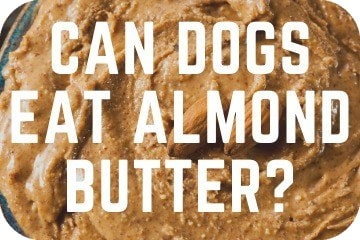
Can dogs eat almond butter? Occasionally, in moderation, it should be safe for dogs. Pure almond butter does not contain anything known to be fatal. But, check for any added ingredients (xylitol, sugar, oil, salt), which could be toxic to dogs.
Almond butter is high in fat and not easy for dogs to digest, so always monitor them when they are eating it. It does contain essential vitamins, as well as being a source of protein and fiber, so it may have some helpful benefits for your pup.
Overall, dogs can enjoy the occasional bit of almond butter. However, it should be used as a treat and not a substitute for dog food. It is not seen to be nutritionally beneficial for them.
If your dog has pancreatitis or weight issues, it is best to avoid nuts in general.
As with all food, make sure it is incorporated into their daily food allowance to avoid obesity. If you are using nut butter as a treat, treats should only make up 10% of your dog’s recommended daily allowance.
Make sure to introduce any new food slowly. Rapidly changing your pet’s diet can result in an upset stomach.
Busy? Get Your Hands Paws On The Answers Quickly…
- What Is Almond Butter?
- How Do You Make Almond Butter?
- Benefits Of Almond Butter
- Risks Of Almond Butter
- Almond Butter vs. Peanut Butter
- Other Nut Butters, Can Dogs Eat Nut Butters?
- How To Feed Your Dog Nut Butters, and Almond Butter Treats
WHAT IS ALMOND BUTTER?
- Almond butter is made by grinding almonds into a paste.
- It is a health food stable for many people following a plant-based diet, or for those looking for a high protein alternative to fatty spreads and sauces. It is a good source of energy and contains many vitamins and minerals, which are great for humans.
- It is an excellent alternative to peanut butter. Whether you or your dog prefer the flavor or have a peanut allergy, it has similar nutritional content and some added vitamins.
- It can be spread on bread, added to smoothies, used in desserts, or as a dressing or sauce.
- It can be made smooth or crunchy to suit all preferences.
- Almond butter is nuttier and richer than peanut butter.
HOW DO YOU MAKE ALMOND BUTTER?

Almond butter is simple to make, it is usually more affordable than buying a pre-made jar, and you know which ingredients are inside, keeping any nasty toxins aways from your furry friend.
100% Almond Butter – Suitable For Dogs and Humans
Ingredients:
- 5 cups almonds
Directions:
1. Preheat the oven to 350 degrees F (176 degrees C).
2. Spread the almonds onto a baking sheet and cook for 10 minutes.
3. Allow to cool to room temperature. Adding hot almonds to the food processor can melt it and cause it to break.
4. Once cool, add to a food processor and blend until creamy. This can take up to 30 minutes, depending on your blender. You may need to scrape the edges down with a spatular every so often.
5. Store in the refrigerator in an airtight container.
BENEFITS OF ALMOND BUTTER
Almond butter should only be used as an occasional treat. A dogs’ primary diet should give them all of the nutrients, minerals, and vitamins they require.
Almonds are also difficult for a dog to digest, so there is a question as to whether they hold any nutritional benefits to them.
High In Protein
Almond butter contains 25.4g protein per 100g. Protein is essential for the maintenance and growth of muscles. It also helps with keeping skin and hair healthy.
Vitamin E
Almonds contain a considerable amount of vitamin E. Vitamin E is beneficial for keeping the immune system healthy and is an antioxidant that can help reduce free radicals.
RISKS OF ALMOND BUTTER
Added Ingredients
Almond butter, which is readily available at the grocery store, is commonly full of added ingredients, which makes the nutty spread more palatable.
Unfortunately, many of these ingredients are unhealthy or even toxic to our dogs.
Ingredients to look out for include:
Sugar – Added for flavor, sugar sweetens the almond butter. Dogs do not need sugar in their diet. Sugar can cause dental problems, behavior-related issues like hyperactivity, and weight gain.
Salt – Dogs need some sodium in their diet for normal functioning, and while this isn’t toxic, it can lead to some health issues. If your dog has consumed an excessive amount of salt, they may become dehydrated or worse, have salt poisoning, which can be fatal.
Xylitol – Xylitol is a sugar substitute that is poisonous to dogs. It sweetens food without adding calories or sugar. It is popular in low calorie, low carb, and low sugar recipes. It is relatively safe for humans to eat but can be fatal to dogs.
Xylitol makes a dog’s body think it has ingested a considerable amount of sugar, leading to a significant insulin release. As sugar is not there, it can lead to hypoglycemia, liver failure, and death.
Palm Oil – Many nut butter recipes add palm oil to thin, or smooth the consistency of the butter. It also works as a cheap filler for many recipes and dilutes the nutty taste, making it more appetizing.
Palm oil is rich and contains a lot of fat. It can have a laxative effect when fed in excess, as well as causing weight gain.
When buying almond butter for your dog, make sure to buy almond butter with no added ingredients. The ingredients list should be 100% almonds. It is also super easy to make your own if this isn’t available.
Fat Content
Almonds contain a large amount of fat. This can pose many problems for dogs, including obesity and pancreatitis. 100g of almond butter contains around 55g fat.
Fat can also cause an upset stomach if fed in high quantities, so if your dog experiences any diarrhea and vomiting, make sure to stop feeding them nuts.
Almond butter should only be fed in a small amount and as an occasional treat.
Toxins
Nuts that have grown mold or that are contaminated can be dangerous for dogs. They contain a toxin, Aspergillus flavus.
This toxin produces aflatoxin. Aflatoxin is present in many nuts, and although some levels are seemingly safe for humans, they can affect dogs differently.
The USDA does regulate the amount in nuts, but it is still unknown as to whether these could cause long term problems (link) (link).
Signs of aflatoxin poisoning include loss of appetite, lethargy, among others. A vet must be contacted if your dog displays any signs.
Nut Allergy
Dogs can be allergic to almost anything, including almonds. Signs of an allergic reaction include puffiness, swelling, sneezing, itching, watery nose, or eyes. If your dog displays any of these signs are consuming nuts, it is best to contact a veterinarian and avoid feeding them any other nuts.
ALMOND BUTTER VS. PEANUT BUTTER

Peanut butter is another nut (or legume technically) butter safe for dogs, as long as it is 100% peanut, with no added ingredients.
Peanut butter is commonly used as a treat for dogs. You can use it inside an enrichment toy, or bake it into dog biscuits. There are also many peanut butter flavored snacks available to dogs, including chew sticks, dental treats, and bite-sized biscuits. Some brands even make peanut butter, especially for dogs!
So which is better for dogs?
Overall Winner: Peanut butter (as long as there are no added ingredients). Peanut butter is considered safer for dogs than almond butter. Read on to find out why.
| 100% Peanut Butter – Smooth (100g) | 100% Almond Butter – Smooth (100g) | |
| Calories | 596 | 650 |
| Fat | 46g | 55.8g |
| of which saturates | 8.2g | 4.4g |
| Carbohydrates | 11.6g | 6.5g |
| of which sugars | 5.9g | 4.0g |
| Fiber | 8.5g | 11.8g |
| Protein | 29.6g | 25.4g |
| Salt | 0g | 0g |
Nutritional Information – Peanut butter is lower in calories and fat. It is also higher in protein. However, almond butter does contain more fiber.
Winner – Peanut Butter
Price and Availability – Peanut butter is more affordable and is easy to find at the store (just be sure to check the ingredients). Many dog brands also make peanut butter cookies and treats for dogs, so if you are looking for a pre-made snack, it is a lot easier to find.
Winner – Peanut Butter
Vitamins and Minerals – They both contain vitamins, but almond butter contains more vitamin E, iron, and calcium than peanut butter.
Winner – Almond Butter
OTHER NUT BUTTERS, CAN DOGS EAT NUT BUTTERS?
Cashew Butter – In moderation. Cashews aren’t deadly to dogs, so as long as it is 100% pure, with no added ingredients, it should be safe for dogs.
Hazelnut Butter – In moderation, you can give your dog hazelnut butter. As long as there are no added ingredients. Chocolate is commonly combined with hazelnuts to create a delicious spread for humans. However, chocolate is highly toxic to dogs.
Brazil Nut Butter – Not really, they are too fatty. But they are not toxic, so if your dog has had some by accident, it shouldn’t be fatal. Read our article on Can Dogs Eat Brazil Nuts here.
Pecan Butter – No.
Pistachio Butter – No.
Walnut Butter – No.
Macadamia Butter – No.
HOW TO FEED YOUR DOG NUT BUTTERS, AND ALMOND BUTTER TREATS
In moderation, almond butter can be used in a dogs’ diet. Here are some of the best ways to use it, including some tasty treats you can make.
Inside A KONG or Hollow Toy – As it is spreadable, almond butter can be enjoyed inside a kong, on a lick mat, or inside any hollow chew or toy you have. Use a small amount and spread it around. If your dog finds this too easy, try freezing the toy for an extra challenge.
To Disguise Medication – Whether it be an unpalatable worm tablet, or something else, almond butter can be wiped around a tablet (if suitable) to disguise the taste.
Straight From The Spoon – If your dog is an almond butter lover, they may just want to lick it straight from the spoon! Keep an eye on the amount they are consuming and for any possible side effects.
Baked Into Treats – Almond butter works well as a binding agent in dog biscuits, it also adds a flavor most dogs are fond of. Here are some of our favorite almond recipes below:
Almond Dog Bones, inspired by Betty Crocker
Ingredients:
- 1/2 cup almond butter
- 1 egg
- 1 cup whole wheat flour
- 1/3 cup water
Directions:
1. Preheat the coven to 350 degrees F (176 degrees C) and line a baking sheet with parchment paper.
2. Combine all of the ingredients in bowl and mix until it forms a ball.
3. Transfer the mixture to a floured work surface and roll out with a rolling pin to 1/2-inch thickness. Add more flour if the dough is sticking.
4. Cut into desired shape and size suitable for your dogs.
5. Bake for 15-20 minutes, depending on the size and shape chosen, or until crisp.
6. Allow to cool before feeding to your dog.
Sweet Potato and Almond Dog Biscuits, inspired by More Than You Can Chew
Ingredients:
- Water, for boiling
- 1 medium sweet potatoes
- 1/3 cup whole wheat flour, plus more for rolling
- 1 tbsp almond butter
Directions:
1. Preheat the oven to 350 degrees F (176 degrees C).
2. Peel and chop the sweet potato into bite-sized chunks.
3. Boil a small saucepan of water on the hob at medium-high.
4. Once boiling, add the chopped sweet potato.
5. Cook until soft, this usually takes 15-20 minutes.
6. Once soft, drain the sweet potato and mash with a fork and leave to cool.
7. Once cool, add the mash, almond butter, and flour. Mix until smooth.
8. Transfer the mixture to a floured work surface and roll out with a rolling pin to 1/2-inch thickness. Add more flour if the dough is sticking.
9. Cut into desired shape and size suitable for your dogs.
10. Bake for 20-25 minutes, depending on the size and shape chosen, or until crisp.
11. Allow to cool before feeding to your dog.
Peanut Butter and Almond Dog Treats
Ingredients:
- 1 carrot
- 1 egg
- 1/4 cup peanut butter
- 1 cup almond flour
Directions:
1. Shred the carrot into a bowl.
2. Crack in the egg.
3. Mix.
4. Add the flour.
5. Mix.
6. Add in the peanut butter.
7. Mix and bring together into a ball.
8. Line a baking sheet and preheat the oven to 350 degrees F (176 degrees C).
9. Use a tablespoon to scoop out the mixture. Roll between your hands to form a ball.
10. Use the back of a fork to flatten the treats.
11. Bake for 20-25 minutes or until golden. Allow to cool before serving to your furry friend.
Looking for more pawsome posts? Check these out…
Can Dogs Eat Lettuce?
How To Make A Snuffle Mat
When Do Puppies Lose Their Teeth?
Can Dogs Eat Broccoli?
Can Dogs Eat Watermelon?
Disclaimer: Each dog is different, and every circumstance is different. All efforts have been made to provide accurate information. However, it is not provided by a qualified Veterinarian, Veterinarian Surgeon, or Behaviorist. The information provided is purely educational. The information should not be used as an alternative or substitute for medical care. If you have any health or medical concerns, contact a qualified Veterinary Surgeon or Veterinarian immediately.










No Comment! Be the first one.